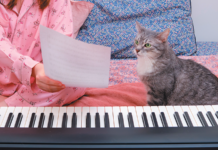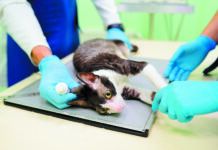According to census figures from the Humane Society of America, well over 90 million cats currently reside in U.S. homes, a record high for the nation’s domestic feline population. Much of the dramatic and steady increase is due to the pleasure that a rising number of people derive from having a cat around the house. However, the increase can also be attributed to the fact that cats are living longer nowadays than they did in the past.
As a consequence of such advances as improved home care, better nutrition and progress in veterinary medicine, it is not uncommon these days for a healthy, well-treated indoor cat to live to the ripe old age of 20 or 21 years — the rough equivalent of 96 to 100 in humans.
Changes in behavior
Unfortunately, however, there’s a downside to this impressive sign of progress. As they grow older, cats, like humans, become increasingly susceptible to age-related disease conditions, and many of these disorders are likely to have an alarming effect on an animal’s behavior.
Arthritis, for example, is apt to cause a formerly rambunctious cat to slow down dramatically as he transitions through his so-called golden years; kidney and urinary tract disease may severely impact his litter box behavior; periodontal disease and tooth loss may alter his eating habits; and progressive hearing loss may make him decreasingly responsive to his environment.
In some cases, however, changes similar to these may not be attributable to a physical disease. These cats may have feline cognitive dysfunction (FCD), a term that broadly describes a condition whose clinical signs resemble those associated with the age-related dementia and Alzheimer’s disease that occurs in humans.
FCD — the consequence of severe and irreversible loss of brain cells and brain atrophy — is by no means uncommon. Indeed, one study has shown that as many as 80 percent of cats 16 years of age and older show signs of the condition. Changes in the brains of affected cats — detected in post mortem examinations — reveal the presence of the same type of deposits (beta amyloid plaques) that are seen in the brains of humans suffering from Alzheimer’s disease and senile dementia.
Clinical signs can vary
The clinical signs of FCD, which can become noticeable in cats as young as 10 years of age — or even earlier in rare cases — vary from animal to animal. “You start seeing the disorder with some frequency in 12-year-old cats,” says Nicholas Dodman, former director of the Animal Behavior Clinic at Tufts and author of The Cat Who Cried for Help: Attitudes, Emotions, and the Psychology of Cats. “You see it somewhat more frequently in cats that are 14 or 15 years old, and way more frequently at 16, 17 and 18. By the time they’re 20 years old, a lot of cats will have it.”
A definitive diagnosis of FCD can be obtained only by means of a post mortem examination of a cat’s brain. However, says Dr. Dodman, a probable diagnosis can be reached in a living animal by excluding possible causative physical disorders — advanced kidney disease or hyperthyroidism, for example — and reviewing a cat’s behavioral patterns represented by the acronym DISHA. In this acronym, the D stands for Disorientation; I for social Interactions; S for Sleep cycle; H for House soiling; and the A for Activity decline.
Dr. Dodman describes the altered behavior of an FCD-afflicted cat as follows: “The animal seems disoriented, wanders aimlessly around the house. He’s not interested in interacting with people, and he shuns any other cats in the household. He spends most of the day sleeping, and during the night he roams through the house, making ghostly sounds. And after a lifetime of appropriate litter box use, he starts having accidents.”
Usually a gradual onset
The emergence of such signs is typically gradual and subtle. “It usually takes time for the owner to realize that the cat’s behavior is changing,” says Dr. Dodman. “It might take months before it occurs to you that these signs might be signaling the onset of cognitive decline.”
As soon as any one of the telltale signs of the disorder becomes apparent, a thorough veterinary examination is in order. The exam will initially focus on ruling out the presence of common physical diseases that could be responsible for the unusual behavior. “The exam will include a complete blood count, blood chemistry profile and urinalysis,” Dr. Dodman notes, “to make sure that the cat doesn’t have a urinary tract infection or failing liver or kidney, which can result in confused behavior. When you’ve ruled out such physical disorders, you’re left with one conclusion: This could be a case of cognitive dysfunction.”
Because FCD is incurable, he says, the purpose of treatment is to improve the symptoms. “We want to buy the cat some time,” Dr. Dodman says. He points out that the only medical treatment likely to be of benefit is Anipryl (selegiline hydrochloride), a medication designed to control the clinical signs associated with cognitive dysfunction in dogs, but that can also be used in cats. “Typically, a low dose of Anipryl will be given by mouth once a day,” says Dr. Dodman. “If no effect is apparent after a few weeks and no side effects have been seen, the dose should be gradually increased until treatment success is achieved or until side effects dictate against further dose increases.”
Researchers hypothesize that dietary supplementation with antioxidants, B vitamins and omega-3 fatty acids may help promote brain health. A commercial food containing these ingredients — Hill’s Prescription Diet b/d — is now available for dogs, although a similar product for cats has not yet come on the market. Nevertheless, ongoing research supports the hypothesis that brain function in middle-aged and older cats can be significantly improved by dietary supplementation with these ingredients.
Provide regular exercise
Although FCD cannot be prevented, says Dr. Dodman, several measures can help to forestall onset of the disorder and the speed with which it progresses. “Your older cat should have plenty of exercise,” he advises, “which is good for his brain as well as his heart, lungs, joints and muscles. Don’t overfeed him, and avoid giving him high-calorie food. You want a leaner, fitter cat, so get in the habit of taking the time to play with him. Anything that might be effective is worth a try. Do whatever you can to keep the cat’s brain and body active. Sometimes you’ll be lucky, and you’ll see some improvement.” — Tom Ewing



